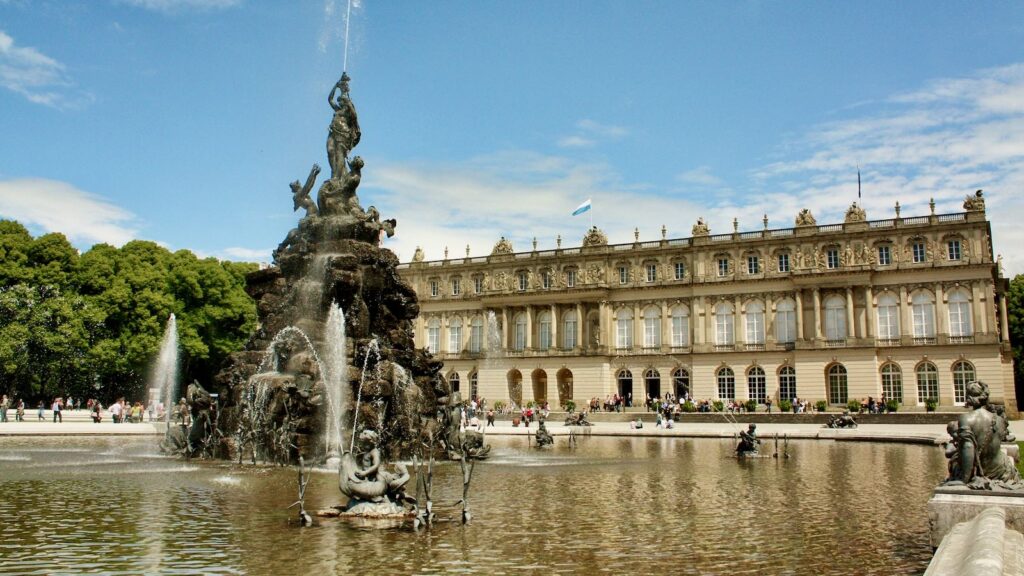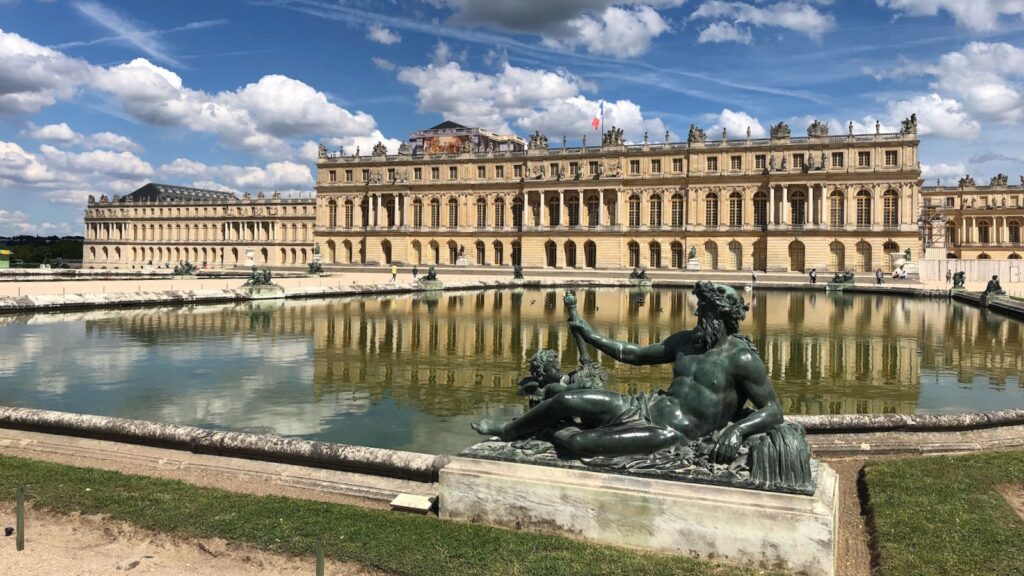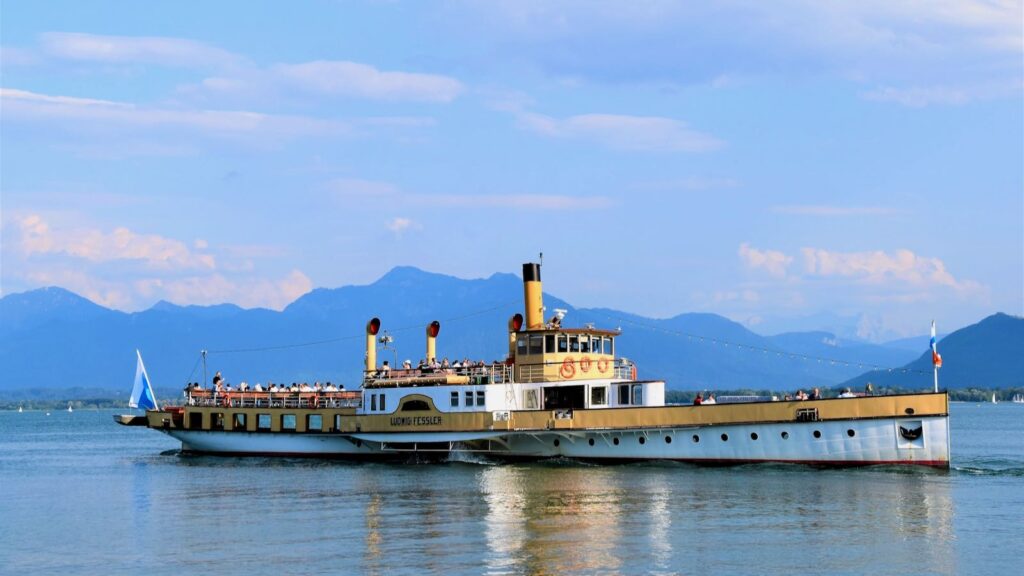King Ludwig II stayed in the magnificent New Palace of Herrenchiemsee for only a few days and had ordered that his “Bavarian Versailles” be destroyed after his death. Fortunately, this royal command was not carried out, and after the Bavarian monarch’s passing, Herrenchiemsee Palace was opened to the public.
Although King Ludwig II’s royal palace was never completed, today it is the most visited sightseeing opportunity on Lake Chiemsee and stands as a fascinating historical testament to the Bavarian monarchy of the 19th century.
Herrenchiemsee Palace (Neues Schloss)

Beginning in 1878, King Ludwig II set out to create a Bavarian version of the Palace of Versailles on Herreninsel island. In contrast to its French model, however, the Bavarian monarch designed his palace as a private residence and tribute to the French aristocracy and not as a functional seat of power.
A striking symbol of the king’s lofty vision is the magnificent State Bedroom, which, according to the Bavarian Ministry of Finance, is considered the most expensive room furnished in the 19th century. The cost of its interior decoration and gilding alone amounts to the equivalent of approximately three million euros.
Beyond its opulent interiors, the location of the palace is equally regal: accessible only by water, it has stood since the late 19th century on the largest island in Bavaria’s largest lake. In front of the palace unfolds a grand baroque-style garden, directly inspired by the grounds of Versailles.
King Ludwig II the “architect”
The death of Bavaria’sfairytale King in Lake Starnberg remains a mystery to this day. What is undisputed, however, is that Ludwig II was a visionary builder. Over the course of his reign, he gradually withdrew from the duties and responsibilities of a constitutional monarch and increasingly devoted himself to his passion for building.
In addition to Herrenchiemsee, King Ludwig II also commissioned the construction of Neuschwanstein and Linderhof, with Herrenchiemsee being the most expensive of the three. Over time, his revenues and expenditures fell dangerously out of balance, and the crushing burden of debt proved disastrous for the royal House of Wittelsbach. Ludwig was declared mentally unfit to rule, placed under guardianship, and taken into custody. Shortly afterward, he was found dead in Lake Starnberg under still unexplained circumstances.
Today, Herrenchiemsee Palace continues to shape the identity of the Chiemgau region and remains a major attraction for locals and visitors from around the world.
Palace of Versailles
The palace of Bavaria’s fairytale King, Ludwig II, was a tribute to the French Sun King, Louis XIV. To Ludwig II, Louis XIV represented the ideal embodiment of an absolute monarch.

After his long-awaited visit to France, King Ludwig II raved about his “beloved Versailles” and commissioned architect Georg Dollmann to study the French palace in detail in order to create a replica. This included recreating rooms that no longer existed at Versailles.
However, upon closer inspection, Herrenchiemsee Palace is far more than just a copy of the French original. For instance, the Hall of Mirrors is longer than its Versailles counterpart and features 23 large mirrors instead of 17. The State Bedroom also surpasses the French original in both scale and splendor.
Notable Rooms at Herrenchiemsee Palace
In addition to the magnificent façade, around 20 rooms were completed and can be viewed during the guided palace tour. Highlights include:
State Bedroom
Without a doubt, this is the most magnificent room in the palace and one of the most expensive of the 19th century. King Ludwig II had over four kilograms of gold leaf used in its decoration, and the room far surpasses its counterpart in the Palace of Versailles in grandeur.
Despite its name, the Bavarian monarch never spent a night in the State Bedroom. It was conceived not as a functional sleeping space, but rather as a monument to the French Sun King, and was never intended for actual use as a bedroom.
Hall of Mirrors
For many visitors, the Hall of Mirrors is the highlight of their visit. Measuring 98 meters in length, this lavishly decorated hall even surpasses its famous model in Versailles. Visitors can admire numerous large wall mirrors, gilded stucco work, and ceiling frescoes. The hall was illuminated by massive chandeliers holding around 2,000 candles.
During the king’s brief stays at the palace, a total of 40,000 candles were used. However, the grandeur of the hall came with a drawback: while the king’s servants were still lighting the last candles, the first ones were already beginning to burn out.
Dining Room
One of the palace’s curiosities that often amuses visitors, is the retractable dining table. This “magic table” imagined by King Ludwig II himself, allowed him to enjoy his meals in peace, without any direct contact with his servants.
The downside of this elaborate setup: it took around thirty minutes to crank the meal up to the dining room, which often meant the food arrived cold. To avoid further cold courses and meals that dragged on for hours, the staff eventually entered the dining room during meals after all, despite the king’s preference for solitude.
The unfinished Herrenchiemsee Palace
The Spiegel Online newspaper once described the palace as a “royal ruin with a panoramic view.” It’s fair to say that what can be seen on Herreninsel island today is only a fraction of what was originally planned. But to judge Herrenchiemsee Palace solely by its incomplete state would be missing the point. Historic palaces bring history to life and Herrenchiemsee leaves room for interpretation – much like the enigmatic and tragic life story of the eccentric King himself.
Visitors may find it helpful to know in advance: the majority of rooms inside the palace remain in an unfinished state, and the palace gardens were originally intended to cover a much larger portion of the island. Despite being incomplete, the cost of building Herrenchiemsee exceeded that of both Neuschwanstein and Linderhof combined.
The heavily indebted Bavarian monarch, who had lost interest in governing alongside his costly passion for building, faced deposition in 1886. Construction ceased with his death that same year, leaving the palace largely unfinished.
Herrenchiemsee Trivia
| Visitors per year: | 270,000 (2022) |
| Duration of build: | 1878-1885 |
| Time spent here by King Ludwig II: | 10 days |
| Finished rooms: | 20 of 70 |
| Gold leaf: | 5 kg |
| Style: | Rokoko, classical barock |
| Most expensive piece: | Royal cabinet |
| Most expensive room: | State bedroom |
| Water features in the gardens: | May to October |
| Building costs: | 16.6 million German Marks (more than Linderhof and Neuschwanstein combined) |
| Investments by the Bavarian State: | 53 million Euro |
Palace Gardens
The palace gardens are just as impressive as the palace itself. Work on the grounds began four years after construction started on the New Palace and was halted upon King Ludwig II’s death. While the area immediately surrounding the palace was largely completed, the original plan envisioned a much more extensive layout, meant to encompass a vast amount of the island.
Versailles also served as a model for the gardens, especially the spectacular water features. Today, various fountains with grand jets of water line the paths through the park, adding to its majestic atmosphere.

The fountain displays in front of the New Palace can be admired from early May to early October. King Ludwig II placed particular importance on the areas of the garden visible from his bedroom and the Hall of Mirrors, sections which were largely completed and remain freely accessible all year round.
King Ludwig II Museum
A museum dedicated to King Ludwig II is located on the ground floor of the New Palace. Visitors can explore the life of the Bavarian king from his birth to his tragic death in Lake Starnberg across 12 rooms. Portraits, busts, photographs, and garments illustrate the key stages of his life. The palace admission ticket also grants entry to the museum. Unlike the palace, visitors may spend as much time as they like in the museum and are also allowed to take photographs.
Getting There
The Herrenchiemsee Palace on Herreninsel island is only accessible by boat. The shuttle service operated by Chiemsee-Schifffahrt departs from Prien am Chiemsee or Gstadt and takes visitors to both Herreninsel island and Fraueninsel island.

Thanks to its good connections and ample parking, most visitors choose Prien as their starting point. Once on the island, you can reach the New Palace either on foot (a 15-minute walk) via the Herreninsel Rundweg path or – just like the fairytale King himself – by horse-drawn carriage.
Guided Tours at Herrenchiemsee Palace
The rooms in the New Palace can only be visited as part of a guided tour. Tours last approximately 40 minutes. From April to October, children’s tours in German are offered (must be accompanied by an adult).
Visitor FAQ
Is photography allowed inside the palace?
No. Photography inside the palace (for private purposes) is not permitted. It is however allowed to take photos of the exterior, gardens and grounds. A photography permit is required for any commercial purposes.
Is a visit to Herrenchiemsee Palace worth it?
Without a doubt, yes. It is in fact a great alternative to the overcrowded Neuschwanstein castle in Füssen. Some visitors may be disappointed by unfinished rooms, but this is simply part of the tragic story of King Ludwig II and his retreat on Lake Chiemsee. The rooms can only be viewed as part of a guided tour, but this is the case for all of Ludwig II’s palaces.
Can I take a stroller/buggy inside the palace?
Yes. The palace is barrier-free and can be visited with your own stroller. Free rental buggies are even available. The Chiemsee boat service and the path from the landing stage to the palace are also suitable for strollers/buggies.
Is the palace suitable for wheelchairs?
Yes. The entrance is accessible via ramps – no steps. Inside, all important areas can be reached step-free via elevators. For wheelchair users, it is recommended to take the boat from Prien, as it offers disabled parking and accessible restrooms. All boats are barrier-free and accessible via ramps.
Can I take my dog with my inside the palace?
No. Dogs unfortunately have to stay outside and must be kept on a line througout the grounds and across the whole island.
Can I visit the inside of the palace without booking a guided tour?
No. The state rooms can only be visited as part of a guided tour. The palace gardens, however, are freely accessible.
Can I walk from the boat to the palace?
Yes – it takes about 15 minutes. Alternatively, you can extend your visit on the island and enjoy the 7km long circular tour of the whole island (Herreninsel Rundweg).
What are the opening times?
Herrenchiemsee Palace is open all year round. Between April and October, tours can be booked from 9:00am -6:00pm. From the end of October until March the tour times are shorter: 10:00am -4:45pm. The palace is closed on 1st January, “Faschingdienstag” and 24th/25th/31th December. Check the official website for more details.
Where can I buy tickets to visit the palace?
Tickets are available at the Visitor Information Centre on Herrenchiemsee island, or from the online Ticket Shop in advance.

